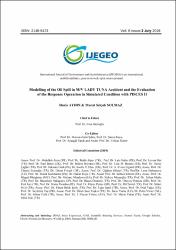Modelling of the Oil Spill in M/V LADY TUNA Accident and the Evaluation of the Response Operation in Simulated Condition with PISCES II
Abstract
Oil pollution from ships is an important source of marine pollution and becomes an important problem all over the world. For this reason, every effort should be made to prevent oil spills and to remove them effectively as soon as pollution has emerged. In this respect, various computer simulations are used to get well informed about the fate of spilled oil on the seawater. In this study, the grounding accident of ship M/V Lady Tuna causing 75 tons of fuel spills into the sea on December 18, 2016, close to the coast of Çesme in Turkey, was investigated. The aim of the study is to investigate the oil spill accident and evaluate the response operation of M/V Lady Tuna. To achieve this aim, firstly the reports related to the accident were examined and the response operation was evaluated by modelling of the M/V Lady Tuna accident with PISCES II (Potential Incident Simulation, Control and Evaluation System) simulator. Within this scope, two scenarios were prepared by using PISCES II. The first scenario was created without any response resources to observe the movement direction of the oil slick after the accident. The second scenario was reconstructed with the possible response resources after the oil spill. Through simulation, it was possible to obtain the oil spill/pollution statistics; such as the recovered oil rate, the amount of stranded oil to the coast, the amount of floating oil rate, and other oil spill parameters. As a result, it was evaluated that the oil pollution in the M/V Lady Tuna accident could be responded more effectively and the pollution could be much less. It is assessed that the study will contribute to organizations involved in oil spill response operations.
Volume
6Issue
2URI
https://doi.oprg/10.30897/jegeo.579066https://app.trdizin.gov.tr/makale/TXpNM01EUTFOUT09
https://hdl.handle.net/20.500.12960/1127

















